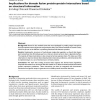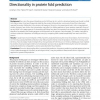385 search results - page 2 / 77 » A Knowledge-Based Method for Protein Structure Refinement an... |
BMCBI
2004
13 years 9 months ago
2004
Background: Several in silico methods exist that were developed to predict protein interactions from the copious amount of genomic and proteomic data. One of these methods is Doma...
BMCBI
2005
13 years 9 months ago
2005
Background: The majority of residues in protein structures are involved in the formation of helices and -strands. These distinctive secondary structure patterns can be used to rep...
BMCBI
2010
13 years 4 months ago
2010
Background: Ever since the ground-breaking work of Anfinsen et al. in which a denatured protein was found to refold to its native state, it has been frequently stated by the prote...
PRIB
2010
Springer
13 years 7 months ago
2010
Springer
Abstract. An important unsolved problem in structural bioinformatics is that of protein structure prediction (PSP), the reconstruction of a biologically plausible three-dimensional...
BMCBI
2007
13 years 10 months ago
2007
Background: Protein motions play an essential role in catalysis and protein-ligand interactions, but are difficult to observe directly. A substantial fraction of protein motions i...


